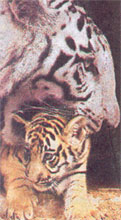The two most magnificent animals from India, the tiger and the peacock both abhor captivity. Both thrive only in the wild. Brightly coloured peafowls bred in captivity are
known to hatch albino peafowls- pure white in colour. The tiger too , change their stripes -their very identity when not allowed free natural selection. Here is an interesting article by Dr. Singh. The detailed research findings are available in the form of
a book which is compelling reading for all wildlife lovers.
COLOUR ABERRATION IN TIGER:
ITS BIOLOGICAL AND CONSERVATION IMPLICATIONS
Dr. Lala A. K. Singh
Similipal Tiger Reserve, Baripada 757002,
Email: laksingh33@hotmail.com
While talking about the body colour of Tiger, we normally mean the yellow or tawny body with black stripes. Variations within normal colouration are attributed to geographical
regions, the forest-habitat, and perhaps the season, as well. In this context, the white Tigers are also discussed and admired as a variation. However, there are at least fourteen known types of body colouration in Tiger, and there could be a larger intermediary
range within these.
 The various forms of colouration now known in Tiger are the
The various forms of colouration now known in Tiger are the
(1). Stripe-less White Tiger,
(2). Tigers with Reduced stripe on white background,
(3). ‘Lighter’ White Tigers, (4). 'Darker' White Tigers,
(5). Golden (Pallid),
(6). Normal (light yellow),
(7). Normal,
(8). Normal (deep yellow),
(9). Rufous,
(10). Brown with dark stripes,
(11). Brown without stripes,
(12). Melanistic,
(13). Blue, and
(14). Black.
All colours other than the “normal” are considered as unusual and aberrations. Colour appears related to body-size. The White Tigers have large body while the Black Tigers
are diminutive. The normal colour of a Tiger and its size are the best compromise for Panthera tigris and are evolution-tested through Natural Selection, and also has the public appeal that has been so essential for Tiger Conservation.
The appearance of Tigers with aberrant colouration can be expected as a regular but extremely rare natural phenomena. Only in populations where inbreeding has a longer and
stronger influence, the appearance of aberrant would be more frequent.
The reports of aberrants are not many because:-- # dismissals of observations have discouraged fresh reporting; # sighting of an aberrant Tiger is an extremely rare event,
and # there is early elimination of aberrants from the population of normal individuals. Aberrant individuals are naturally eliminated from a population because the species are not meant to be like that. Elimination is effected through (a) unsuitable structural
or physiological organization, or (b) early separation from the mother.
Today, threats to Tiger continues because of growing human population, and it is not known in what exact direction the evolution of Tiger is proceeding now. The possibilities
of appearance of more numbers of aberrants cannot be ruled out if populations become small, fragmented and isolated. Large and contiguous patches of forest, if necessary with corridors, may improve 'genetic exchange' and reduce genetic erosion. Conservation
of Tiger requires to be aimed at reducing the possibility of genetic erosion in the wild through habitat improvement.
Details in :
Singh, L. A. K. (1999):
Born Black: The Melanistic Tiger in India.
WWF-India, New Delhi, 1999.66pp.
(Picture courtesy: Alipore Zoo, Kolkata)